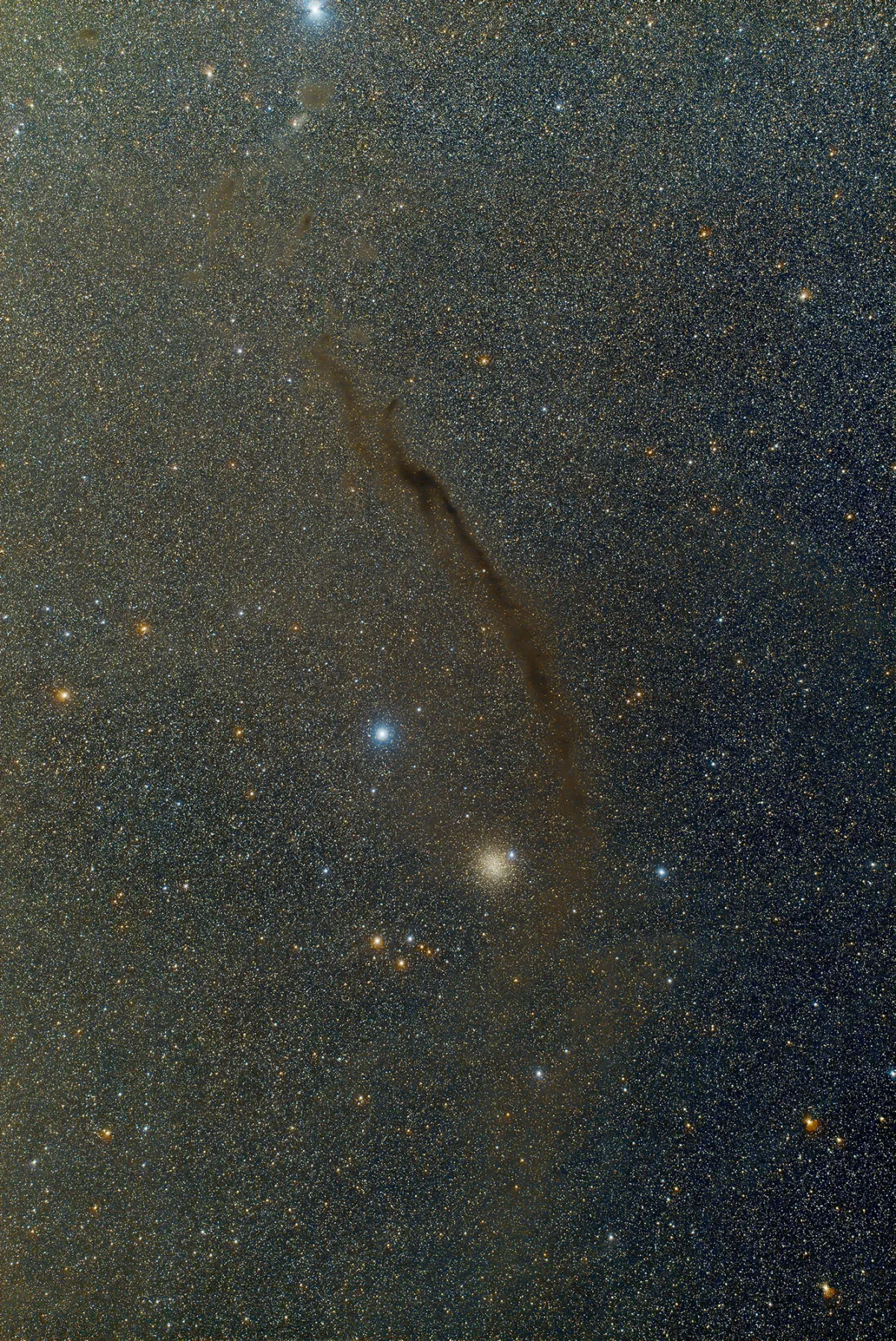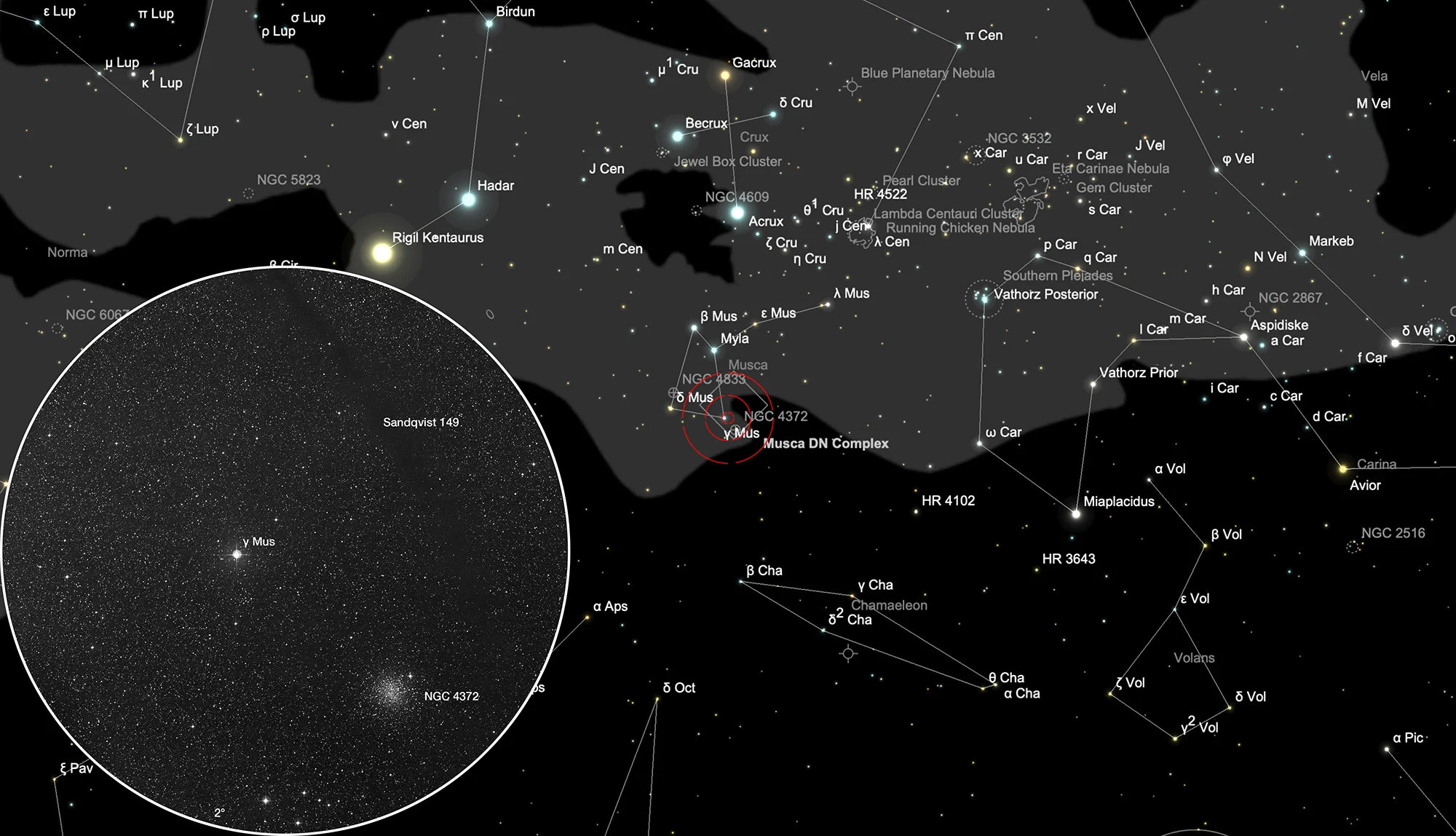Dark Doodad (Sandqvist 149) & Globular Cluster NGC 4372


Dark Doodad Nebula
The dark nebula was discovered in 1977 by Swedish astronomer Aage Sandqvist during a study for dark dust clouds of high visual opacity of the ESO (B) Atlas, which was taken with the ESO 1 m Schmidt telescope at La Silla, Chile. Individual patches of this molecular cloud were listed as numbers 141, 143, 145, 146, 147, 149, 151, 152 in his publication. [657] Although Sandqvist 145 is listed as the largest cloud, Simbad lists for Sandqvist 149 the most bibliographical references (14). Hence it is considered as the main designation for the whole molecular cloud.
The nickname «Dark Doodad» is credited to Dennis DiCicco, American astronomer and former member of the editorial staff of «Sky and Telescope» magazine, while he was in Australia observing Halley’s Comet in 1986. [658] A «doodad» is a slang expression for an item or article that one does not know the name of. Sometimes the nebula is just referred as «Musca Nebula» or «Musca Dark Nebula».
It is a narrow molecular cloud stretching approximately 3° across the sky. With an estimated distance of 700 light-years it is relatively close. Given that distance the cloud is over 30 light-years long. [658]
| Name | Right Ascension (J2000.0) | Declination (J2000.0) | Area (deg2) | Opacity Class |
|---|---|---|---|---|
| Sandqvist 141 | 12 23 24 | -72 22 01 | 0.033 | 4 |
| Sandqvist 143 | 12 25 48 | -71 40 58 | 0.036 | 4 |
| Sandqvist 145 | 12 31 29 | -71 03 36 | 0.072 | 6 |
| Sandqvist 146 | 12 35 54 | -70 37 01 | 0.022 | 5 |
| Sandqvist 147 | 12 36 56 | -69 30 42 | 0.012 | 5 |
| Sandqvist 149 | 12 37 09 | -69 59 54 | 0.005 | 6 |
| Sandqvist 151 | 12 40 55 | -69 52 18 | 0.004 | 6 |
| Sandqvist 152 | 12 47 30 | -69 15 00 | 0.004 | 6 |
Globular Cluster NGC 4372
The globular cluster NGC 4372 was discovered on 30 April 1826 by James Dunlop using his 9-inch f/12 speculum reflector from Parramatta, NSW. He listed it as object number (D 67) and wrote the following:
«A star of the 6th magnitude, with a beautiful well-defined milky ray proceeding from it south following; the ray is conical, and the star appears in the point of the cone, and the broad or south following extremity is circular, or rounded off. The ray is about 7' in length, and nearly 2' in breadth at the broadest part, near the southern extremity. With the sweeping power this appears like a star with a very faint milky ray south following, the ray gradually spreading in breadth from the star, and rounded off at the broader end. But with a higher power it is not a star with a ray, but a very faint nebula, and the star is not involved or connected with it: I should call it a very faint nebula of a long oval shape, the smaller end towards the star; this is easily resolvable into extremely minute points or stars, but I cannot discover the slightest indications of attraction or condensation towards any part of it. I certainly had not the least suspicion of this object being resolvable when I discovered it with the sweeping power, nor even when I examined it a second time; it is a beautiful object, of a uniform faint light.» [50]
| Designation | NGC 4372 |
| Type | GCL (XII) |
| Right Ascension (J2000.0) | 12h 25m 45.4s |
| Declination (J2000.0) | -72° 39' 31" |
| Diameter | 5 arcmin |
| Visual magnitude | 7.2 mag |
| Metric Distance | 5.800 kpc |
| Dreyer Description | globular, pF, L, R, st 12…16 |
| Identification, Remarks | h 3390; GC 2927; GCL 19; ESO 64-SC6 |
Finder Chart
The dark nebula Sandqvist 143 (Dark Doodad) and globular cluster NGC 4372 are located in the constellation Musca near 3.8 mag star γ Muscae. At a declination of -71° these are thus not visible from the northern hemisphere. On 31 March it in opposition with the Sun and is therefore highest in the sky at local midnight.
